We left on December 4th at 4:00 pm from Isla San Jose heading to Isla Iguana, about 80 miles away on the opposite side of the Gulf of Panama, which sometimes can be difficult to cross due to its infamous gusty winds. The forecast was favorable with predicted winds of 10-15 kn. During the night the wind changed direction and speed, making the route to Isla Iguana challenging and with an arrival time at night; this is something we like to avoid when we do not know the place where we are landing. Therefore, we changed our plans to get to Ensenada Benao, an additional 10 miles away, where we ended up anchoring at about 7:00 am on December 5th.
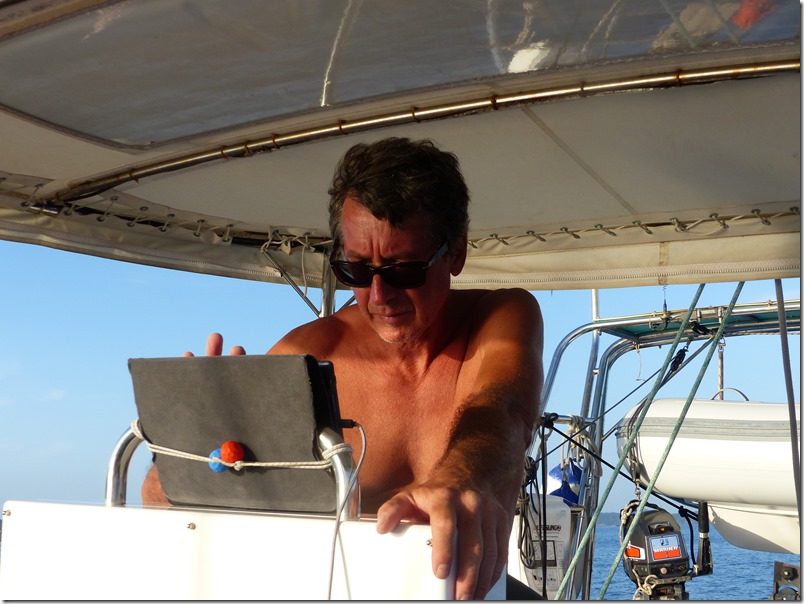
December 4th – Leaving Isla San Jose’
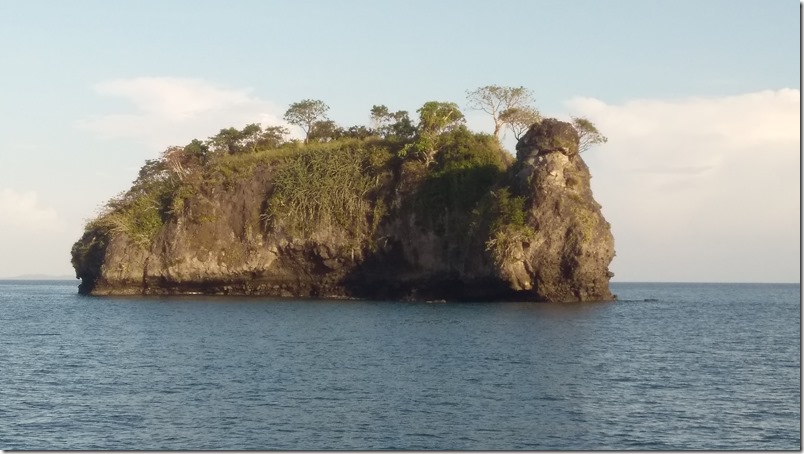
December 4th – Mogote South of Isla San Jose’
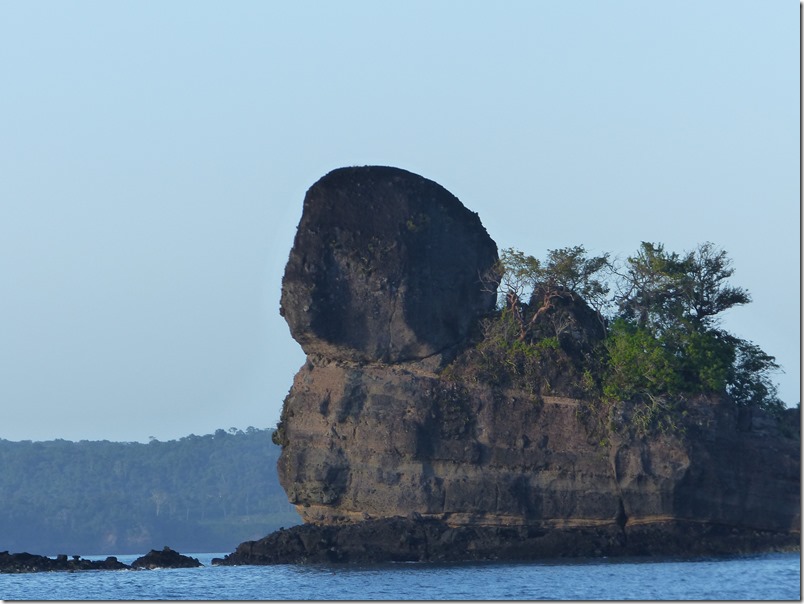
December 4th – Other Mogote South of Isla San Jose’
Ensenado Benao is a large sandy bay where a few resorts have been built. We used this stop mainly to rest and repair the main sail that during the passage started ripping off in a couple of spots. We were aware that the main sail would have not lasted long, as its material is not appropriate for the hot weather in this side of the world. Differently from the genoa, we did not replace this sail before the departure from Rome, even if the sailmaker warned us about its light construction. So we took down the sail and used half of the 5 square meters of sticky patch we brought with us to temporarily fix the problem. We know that our next significant expense will be for a new main sail.
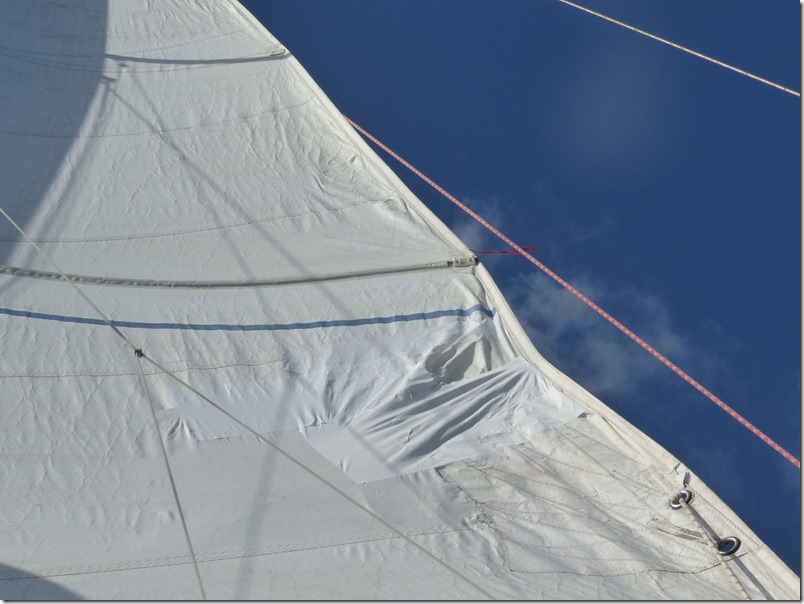
December 6th – Patches on the mainsail
At this point we need to make a digression. A few days earlier we realized that Gemma’s passport was expiring at the end of February 2019. We needed to find a consulate where to renew the passport. First, we called the embassy in Panama, but we were not able to talk to anyone on the phone. We then tried with the Mexican embassy, where they told us we should get an appointment to bring the old passport, and then wait for about 10 days until they would have got clearance from the police in Rome to release the new passport. We also tried to call the embassy in Costa Rica, and we were lucky to speak with Nello, the employee in charge of the passport office. We immediately got in tune with him as he was very interested and curious about our sailing experience. He offered to request clearance from Italy upon an email with Gemma’s scanned documents, avoiding us to make two trips. Not only this, but also we agreed he would come sail with us during his Christmas vacations. We then set an appointment for December 14th at the Italian Embassy in San Jose’. Therefore, we decided to head to Pedregal, a small village on a river close to the city of David, where there are daily buses to San Jose’.
On December 6th we left Ensenada Benao with the wind on our back heading north west to Ensenado Naranjo, where despite our wish we arrived at night, as the wind dropped significantly and there was no sheltered anchorage before.
The day after we got to Isla Cebaco, an island with a few villages and an extensive banana plantation. Here we spent the whole afternoon searching internet for a new starter motor and the best way to get it delivered. We ended up ordering it from a Yanmar dealer in Miami who would have shipped it in a couple of days to MBE, a freight forwarder that in an additional few days would have delivered the spare part in David. In fact, soon after we crossed the Canal, every now and then the engine would not start, and as the time passed this was happening more and more frequently. So, after a thorough analysis and a phone consultation with our friend, Mirko, from our point of view the best mechanic of the world, we decided we could not wait but order a new starter motor. By the way, in a few days you’ll see that the passport and the starter motor stories will mix.
From Cebaco we made a stop in Isla Santa Catalina (Dec 8th) where we met the first sailboat since we left Panama! Even if we had no chance to interact with its occupants, we felt a bit less alone in the sea! In front of Isla Catalina there are long long beaches famous to surfers for the the high waves, though at the time we were there the sea was quite calm.
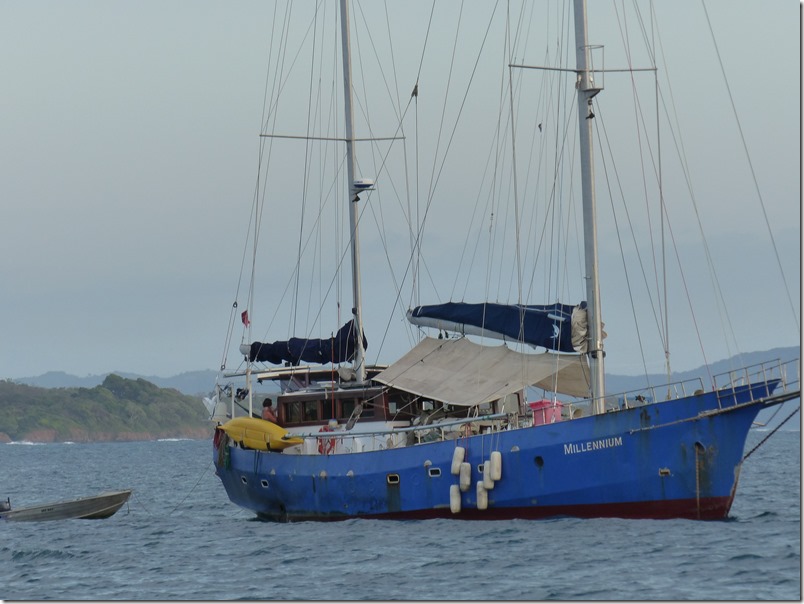
December 8th – Sailboat at the anchor at Isla Santa Catalina
Time was becoming tight, so we kept going and got to Isla Secas by sunset. While anchoring, we noticed a lot of bubbling on the water, but at the moment we did not pay too much attention. Later, we were astonished and enchanted by a very peculiar phenomenon: hundreds of trumpet fishes, blue, approximately 70 cm long, were making a carousel of jumps all around the boat. They were running over the water for several meters in a sequence of 3-4 jumps,like if you were throwing a flat stone over a patch of calm water. This carousel continued all over the night, preventing us from falling asleep for quite a while. We promised ourselves to return here.
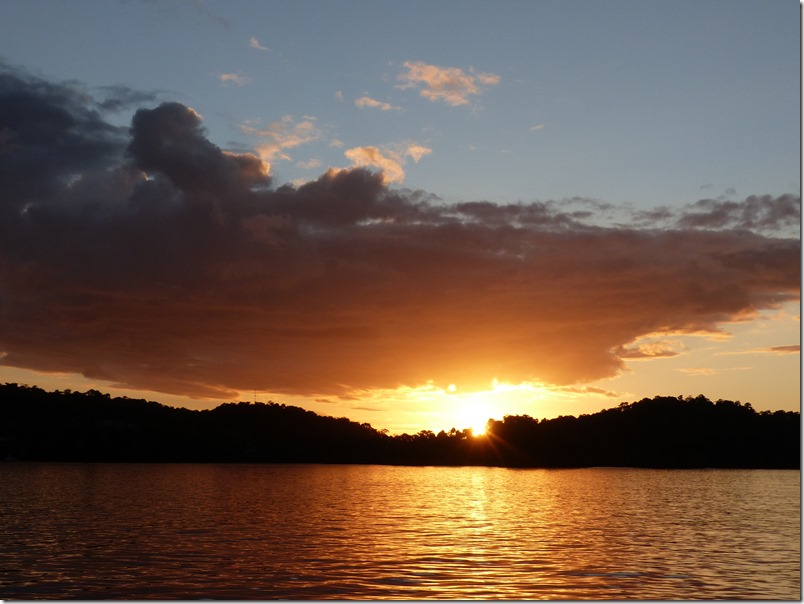
December 9th – Sunset at Islas Secas
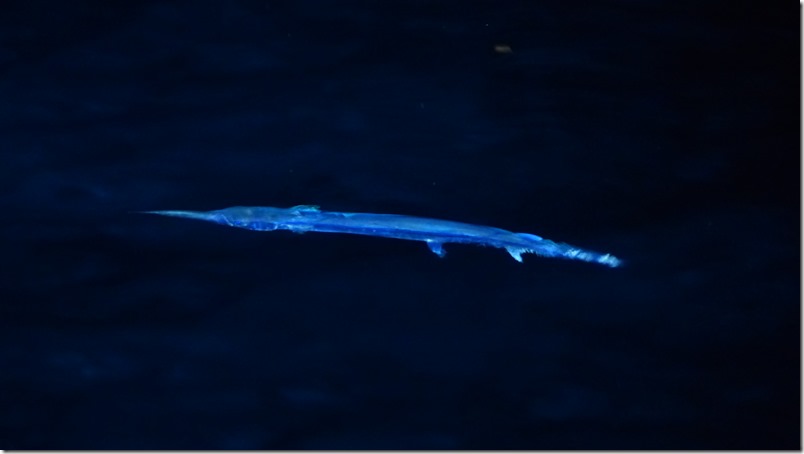
December 9th – Trumpet fish at Islas Secas
The next morning we left Isla Las Secas heading to Isla Bolanos, an intermediate stop to enter the river leading into Pedregal with the raising tide. After lunch, when it was time to leave, the engine would not start! For about a hour Sergio made several attempts until with apparent no reason the engine turned on! Such an experience convinced us not to turn off the engine till we were safely anchored at the marina in Pedregal. To get there, it is not that straightforward. In fact, you must sail up a river for about 20 miles, with sections that can be navigated only at high tide. This means that a boat like ours cannot make the entire course in one shot, but has to make a night stop waiting for the next high tide. So we did, anchoring in the middle of the river from 6pm until 4am with the engine running! Despite this inconvenience, the experience was really enjoyable; when entering the estuary, we were approached by a school of large dolphins that accompanied us for about an hour, amusing us with jumps and other acrobatics: some of them came so close to the boat that seemed to be looking at us with curiosity (please, forgive the anthropomorphism!!). Also navigating the calm waters of the river, admiring the unusual scenery and the hundreds of birds flying to their nests at sunset was unforgettable.
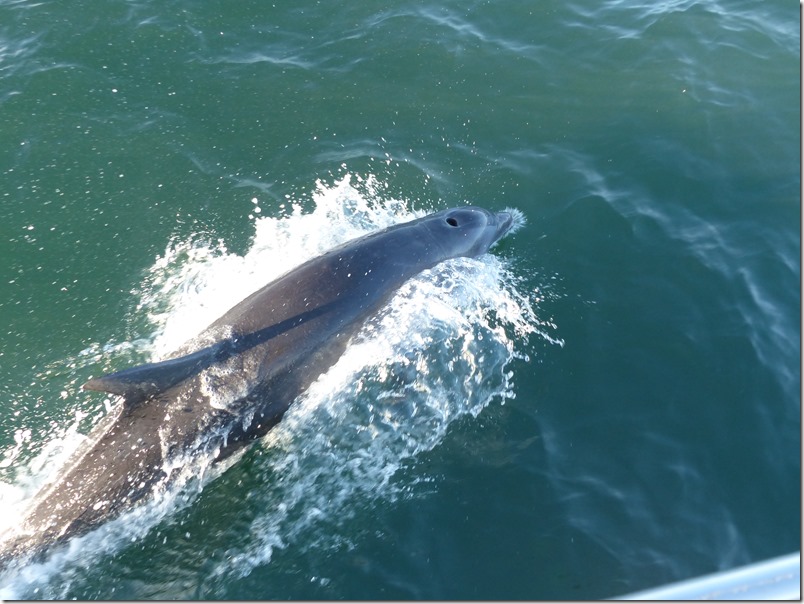
December 10th – Dolphins at Boca Brava
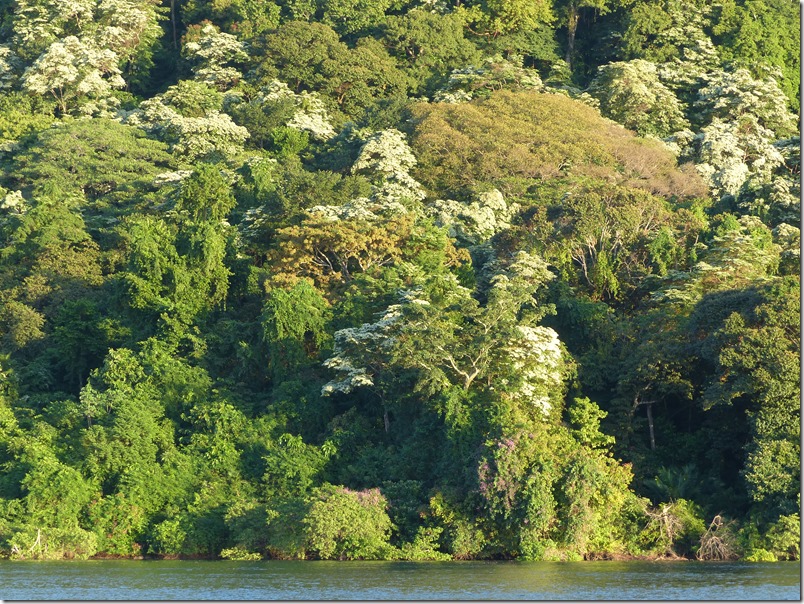
December 10th – Sailing up the river
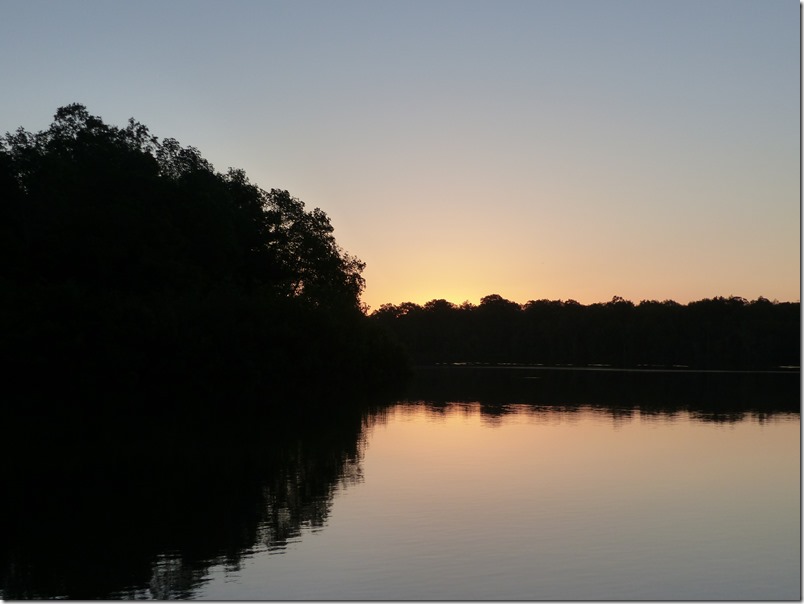
December 10th- At the anchor for the night on the river
When early in the morning we approached Pedregal we immediately realized that the term “port” was an overestimation; a few fishing boats were moored along dilapidated docks in shallow, muddy waters. Nobody was around apart from a guy who gestured and screamed something to us from a catamaran anchored close to the mangroves. That’s the way we met Beto! He jumped on a dinghy and rowed with energy toward our boat, while trying to communicate with us in a weird (to us) Spanish. When he got close to our boat he succeeded to explain us that the “jefe” (the master captain) of the port would have arrived at 8:00, and offered to call him on his mobile. We were a little anxious because, given the engine problem, we needed to moore and it did not seem so obvious that we would have had a place where to safely leave the boat. The master showed up at around 8:30 and kindly explained us that only one place was available, but that he would not recommend it. In fact, the dock was 3 meters long, good to moore a dinghy; plus we found out that this would have cost us an unreasonable and unjustified amount of money. The alternative was to moore attached to the catamaran and pay a much more reasonable amount of money to Beto who was already taking care for that boat, since the owner, a French guy, suddenly had to return home. We agreed with that solution and it was definitely for the best.
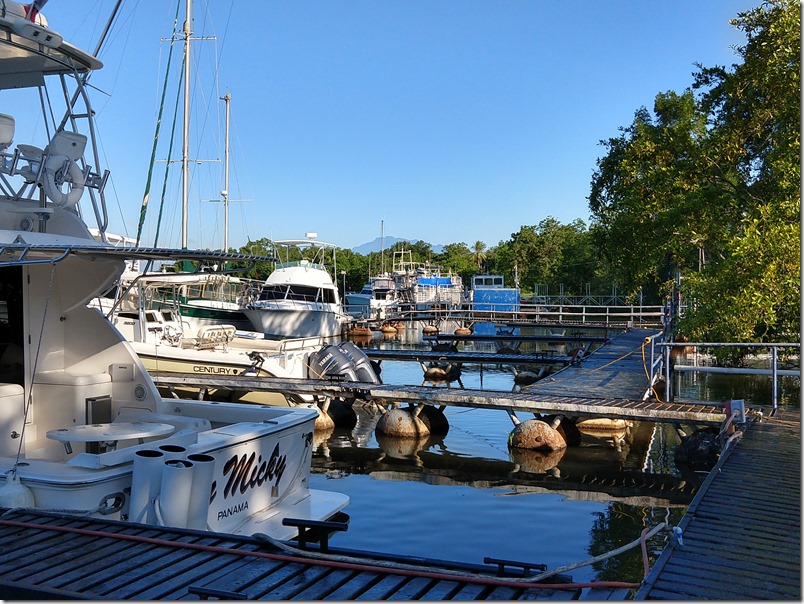
December 11th – Pedregal Marina
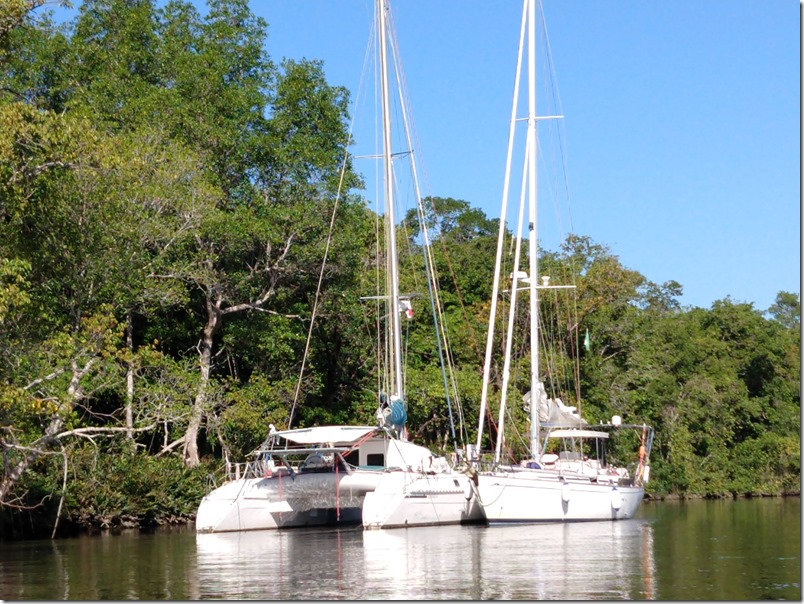
December 11th – Zoe moored next to the catamaran
As soon as the sun started fading out, a cloud of no-see-’em invaded the boat. No-see’em are a 1mm kind of mosquito that byte instead of puncturing, causing hitches that last several days – you typically find them next to the mangroves. The only preventive measure is to “shower” with a very oily and sticky repellent. Therefore, we decided to anticipate our trip to San Jose to the following day, hoping to find the starter motor at the MBE office (the freight forwarder company which we used to ship it from Miami to Panama) on our way back from San Jose’.
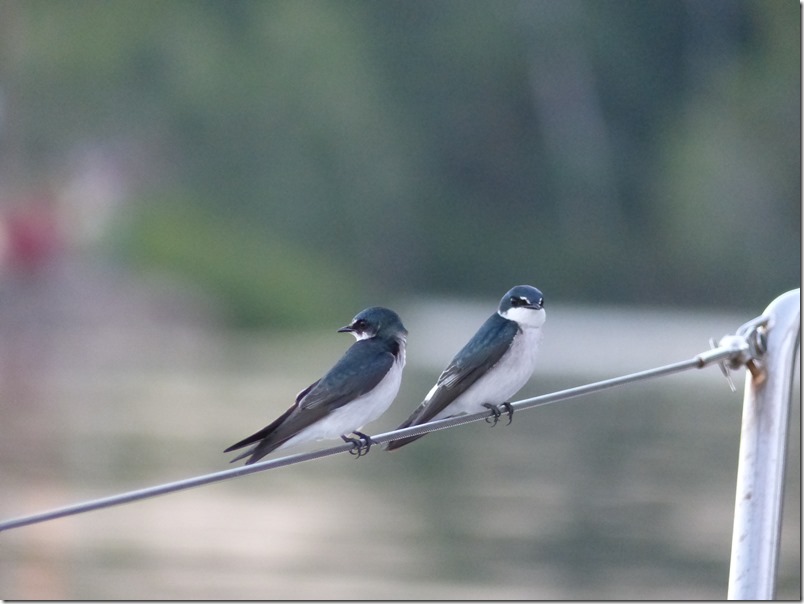
December 12th – Birds resting on our boat
From Las Perlas to Pedregal (320 nm)
We left on December 4th at 4:00 pm from Isla San Jose heading to Isla Iguana, about 80 miles away on the opposite side of the Gulf of Panama, which sometimes can be difficult to cross due to its infamous gusty winds. The forecast was favorable with predicted winds of 10-15 kn. During the night the wind changed direction and speed, making the route to Isla Iguana challenging and with an arrival time at night; this is something we like to avoid when we do not know the place where we are landing. Therefore, we changed our plans to get to Ensenada Benao, an additional 10 miles away, where we ended up anchoring at about 7:00 am on December 5th.
December 4th – Leaving Isla San Jose’
December 4th – Mogote South of Isla San Jose’
December 4th – Other Mogote South of Isla San Jose’
Ensenado Benao is a large sandy bay where a few resorts have been built. We used this stop mainly to rest and repair the main sail that during the passage started ripping off in a couple of spots. We were aware that the main sail would have not lasted long, as its material is not appropriate for the hot weather in this side of the world. Differently from the genoa, we did not replace this sail before the departure from Rome, even if the sailmaker warned us about its light construction. So we took down the sail and used half of the 5 square meters of sticky patch we brought with us to temporarily fix the problem. We know that our next significant expense will be for a new main sail.
December 6th – Patches on the mainsail
At this point we need to make a digression. A few days earlier we realized that Gemma’s passport was expiring at the end of February 2019. We needed to find a consulate where to renew the passport. First, we called the embassy in Panama, but we were not able to talk to anyone on the phone. We then tried with the Mexican embassy, where they told us we should get an appointment to bring the old passport, and then wait for about 10 days until they would have got clearance from the police in Rome to release the new passport. We also tried to call the embassy in Costa Rica, and we were lucky to speak with Nello, the employee in charge of the passport office. We immediately got in tune with him as he was very interested and curious about our sailing experience. He offered to request clearance from Italy upon an email with Gemma’s scanned documents, avoiding us to make two trips. Not only this, but also we agreed he would come sail with us during his Christmas vacations. We then set an appointment for December 14th at the Italian Embassy in San Jose’. Therefore, we decided to head to Pedregal, a small village on a river close to the city of David, where there are daily buses to San Jose’.
On December 6th we left Ensenada Benao with the wind on our back heading north west to Ensenado Naranjo, where despite our wish we arrived at night, as the wind dropped significantly and there was no sheltered anchorage before.
The day after we got to Isla Cebaco, an island with a few villages and an extensive banana plantation. Here we spent the whole afternoon searching internet for a new starter motor and the best way to get it delivered. We ended up ordering it from a Yanmar dealer in Miami who would have shipped it in a couple of days to MBE, a freight forwarder that in an additional few days would have delivered the spare part in David. In fact, soon after we crossed the Canal, every now and then the engine would not start, and as the time passed this was happening more and more frequently. So, after a thorough analysis and a phone consultation with our friend, Mirko, from our point of view the best mechanic of the world, we decided we could not wait but order a new starter motor. By the way, in a few days you’ll see that the passport and the starter motor stories will mix.
From Cebaco we made a stop in Isla Santa Catalina (Dec 8th) where we met the first sailboat since we left Panama! Even if we had no chance to interact with its occupants, we felt a bit less alone in the sea! In front of Isla Catalina there are long long beaches famous to surfers for the the high waves, though at the time we were there the sea was quite calm.
December 8th – Sailboat at the anchor at Isla Santa Catalina
Time was becoming tight, so we kept going and got to Isla Secas by sunset. While anchoring, we noticed a lot of bubbling on the water, but at the moment we did not pay too much attention. Later, we were astonished and enchanted by a very peculiar phenomenon: hundreds of trumpet fishes, blue, approximately 70 cm long, were making a carousel of jumps all around the boat. They were running over the water for several meters in a sequence of 3-4 jumps,like if you were throwing a flat stone over a patch of calm water. This carousel continued all over the night, preventing us from falling asleep for quite a while. We promised ourselves to return here.
December 9th – Sunset at Islas Secas
December 9th – Trumpet fish at Islas Secas
The next morning we left Isla Las Secas heading to Isla Bolanos, an intermediate stop to enter the river leading into Pedregal with the raising tide. After lunch, when it was time to leave, the engine would not start! For about a hour Sergio made several attempts until with apparent no reason the engine turned on! Such an experience convinced us not to turn off the engine till we were safely anchored at the marina in Pedregal. To get there, it is not that straightforward. In fact, you must sail up a river for about 20 miles, with sections that can be navigated only at high tide. This means that a boat like ours cannot make the entire course in one shot, but has to make a night stop waiting for the next high tide. So we did, anchoring in the middle of the river from 6pm until 4am with the engine running! Despite this inconvenience, the experience was really enjoyable; when entering the estuary, we were approached by a school of large dolphins that accompanied us for about an hour, amusing us with jumps and other acrobatics: some of them came so close to the boat that seemed to be looking at us with curiosity (please, forgive the anthropomorphism!!). Also navigating the calm waters of the river, admiring the unusual scenery and the hundreds of birds flying to their nests at sunset was unforgettable.
December 10th – Dolphins at Boca Brava
December 10th – Sailing up the river
December 10th- At the anchor for the night on the river
When early in the morning we approached Pedregal we immediately realized that the term “port” was an overestimation; a few fishing boats were moored along dilapidated docks in shallow, muddy waters. Nobody was around apart from a guy who gestured and screamed something to us from a catamaran anchored close to the mangroves. That’s the way we met Beto! He jumped on a dinghy and rowed with energy toward our boat, while trying to communicate with us in a weird (to us) Spanish. When he got close to our boat he succeeded to explain us that the “jefe” (the master captain) of the port would have arrived at 8:00, and offered to call him on his mobile. We were a little anxious because, given the engine problem, we needed to moore and it did not seem so obvious that we would have had a place where to safely leave the boat. The master showed up at around 8:30 and kindly explained us that only one place was available, but that he would not recommend it. In fact, the dock was 3 meters long, good to moore a dinghy; plus we found out that this would have cost us an unreasonable and unjustified amount of money. The alternative was to moore attached to the catamaran and pay a much more reasonable amount of money to Beto who was already taking care for that boat, since the owner, a French guy, suddenly had to return home. We agreed with that solution and it was definitely for the best.
December 11th – Pedregal Marina
December 11th – Zoe moored next to the catamaran
As soon as the sun started fading out, a cloud of no-see-’em invaded the boat. No-see’em are a 1mm kind of mosquito that byte instead of puncturing, causing hitches that last several days – you typically find them next to the mangroves. The only preventive measure is to “shower” with a very oily and sticky repellent. Therefore, we decided to anticipate our trip to San Jose to the following day, hoping to find the starter motor at the MBE office (the freight forwarder company which we used to ship it from Miami to Panama) on our way back from San Jose’.
December 12th – Birds resting on our boat